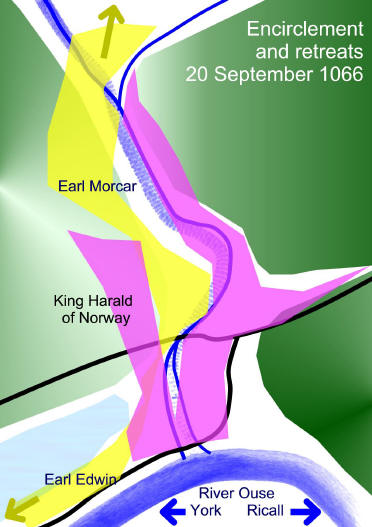Sunrise - Confrontation - Battle begins - Turning point - Rollup begins - Encirclement Home
|
There were now 3 main battlefronts at Fulford. The Vikings cut into the troops on the high ground. They were now behind the English troops attacking at the Ford. The defenders who now found themselves with enemy on 3 sides. There were 2 retreats in progress. When retreating nearly all the advantages lie with the pursuers who could direct their weapons at the undefended backs of those fleeing towards York.
It is probable that the two Earls still led their men. The Earls might have been able to bring some order to the retreat. The records state that the surrender of the City was by negotiation which suggests that the defenders were not routed. They probably moved back inside the city walls, secured and manned the defences. York was safe for the moment. The injured who had not reached sanctuary were dispatched and hacked by their pursuers. |
 No amount of bravery could save these defenders. Wading through the heavy mud was exhausting and soon impossible. Unable to move and dodge blows, they were easy prey. The Chroniclers description of a causeway of bodies might be accurate. Perhaps 500 men were trapped in this morass. There is little chance that any of this doomed band could have escaped. Although one version of the Anglo-Saxon Chronicle records them as fighting their way to Heslington, a mile away along the Beck. It is over this precise ground that modern developers plan to build their access road.
|
|
|